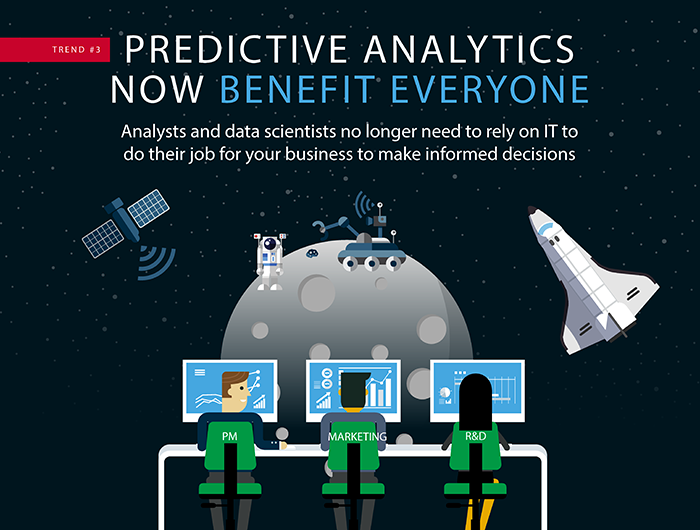4 Hot Business Intelligence Trends: Predictive Analytics and Machine Learning Hits Its Stride (Part 3 of 4)
As the famous quote attributed to George Santayana goes, ‘Those who don’t learn history are doomed to repeat it.’ In business today, history is often locked away in data generated months or years earlier. Now, thanks to a new generation of truly user-friendly predictive analytics solutions, leading edge companies are able to forecast what might happen to their businesses based on that trove of historical data. Or, as Shakespeare wrote, ‘What’s past is prologue.’
For the record, predictive analytics is a subset of data mining focused on predicting future trends and probabilities. Using predictive models, the tools seek patterns in historical and transactional data to identify risks and opportunities yet unfolding.
What’s more, predictive analytics provides a numerical, predictive score or probability that something will happen, such as the likelihood an individual or small business will pay back a loan they are seeking. In fact credit scoring is a primary use case for predictive analytics.
Use cases
The generation of these predictive scores or probabilities is what separates predictive analytics from conventional forecasting. In general business operations, predictive analytics is being used to predict the number of guests that will check into a hotel on a given weekend; airlines use the solution to determine how many tickets they should sell at each different price for a flight; power utilities analyze mountains of historical data to predict system failures (and take corrective actions to head them off); manufacturers are using predictive analytics to determine future inventory levels and therefore factory floor output today.
This exciting class of business solution enables the discovery, analysis and ability to act on data by learning from the past. Predictive analytics also provides a general framework to analyze data over time to enable ever more refined outcomes.
Predictive analytics is fast becoming an essential business tool, in large measure because it is now a self-service tool for ‘regular folks’, that is to say, non-IT professionals who are also not data scientists. That is a far cry from the analytics of old, where executives and other business leaders went on their bended knee to the IT department to get trending reports and other vital information. Getting the final output could take days, even a week or more if IT was backed up or just busy fighting fires. With today’s solutions, there is no need to burden IT when undertaking a predictive analytics task.
Here below are a few justifications and reasons why your organization should look seriously at predictive analytics.
- Grow the business. As it turns out, marketing and sales are the two hottest areas for predictive analytics applications, both of which are charged with growth responsibilities. Predictive analytics allows these groups to score individual customers, or classes of customers, by viewing and analyzing click data, actual sales, and responses to various campaigns. In turn this scoring can instigate changes in everything from site design to special offers. Also, the ability to more accurately predict the impact of direct marketing campaigns can be vital to optimizing marketing spending. A business can simply eliminate from campaigns customers least likely to respond and focus on the ones that are more likely. The result can be lower overall mailing costs and a higher ‘hit rate’ of those identified by predictive analytics as the best potential buyers.
- Do a better job of managing fraud. Whether it is from false insurance claims, stolen credit card purchases, fraudulent tax returns, or many other schemes, fraud abounds. And banks and businesses often get stuck with the bills, deservedly or not. Predictive analytics can score and rank historical transactions to foresee the likelihood of fraud, allowing time to take better preventative actions.
- Compete harder and more effectively. Organizations will deploy predictive analytics for a lot of reasons, but chief among them has to be the drive to compete better. Think of it this way. Any business can squeeze another point or two of margin from a manufacturing or business process. That’s table stakes, not competitive differentiation. But with predictive analytics, each business has the opportunity to mine its own unique historical and transactional data to gain a similarly unique view of what will happen in the future, given certain variables. That is a true wellspring of differentiation, and therefore of competitive advantage.
Conclusion
The tremendous ease-of-use of today’s predictive analytics solutions has transformed these highly valuable tools into the mainstream whereby just about any knowledge worker can leverage them, without help from the IT department. The fact that most such solutions are fully cloud-enabled makes them even more readily if not instantly available. Whether your organization’s goals are deeper customer insight; predicting equipment failure for proactive maintenance; detected fraud before it happens; or making optimal decisions about business loans, predictive analytics is the tool for peering around the corner and into the future.
Learn more by downloading the free book: The Definitive Guide to BI and Analytics on a Data Lake.
| Reference: | 4 Hot Business Intelligence Trends: Predictive Analytics and Machine Learning Hits Its Stride (Part 3 of 4) from our JCG partner Sameer Nori at the Mapr blog. |





